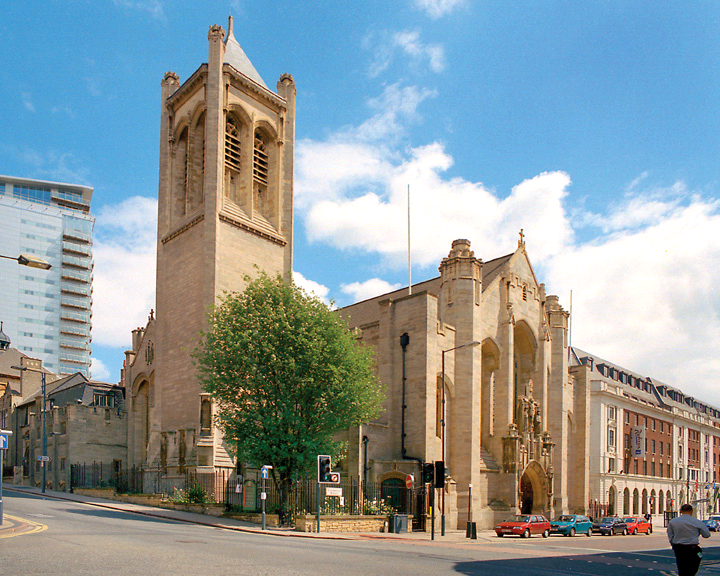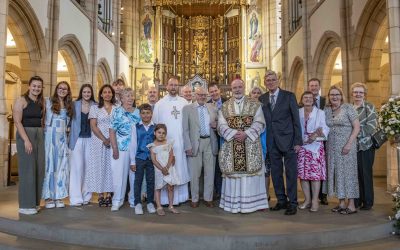Saturday 30 July 2022 marks the Centenary of GK Chesterton’s reception into the Catholic Church, brought about through his friendship with a priest of the Diocese of Leeds, Fr John O’Connor (1870-1952) who was the inspiration for Chesterton’s most famous creation: Father Brown.
Chesterton and his wife, Frances, lived in Beaconsfield, Buckinghamshire, and as the town had no Catholic parish at the time, Fr O’Connor actually received Gilbert into the Catholic Church in an upper room of the Railway Hotel!
The two men had first met in Yorkshire where O’Connor was a curate at St Anne’s in Keighley. GK had just delivered a lecture in the town and was on his way to visit a German Jewish friend in Ilkley, whom O’Connor also knew. It was in a walk over Ilkley Moor together that John O’Connor first set Gilbert Chesterton on the ‘Path to Rome’.
As well as St Anne’s in Keighley, some of the churches and schools in the Leeds Diocese where Fr O’Connor served as a priest and chaplain include St Joseph’s Church and St Bede’s Grammar School in Bradford, Holy Spirit Heckmondwike, St Cuthbert’s and finally the First Martyrs of Rome in Bradford.
Gilbert Keith Chesterton (1874-1936) was one of Britain’s most prolific authors and essayists; he was a renowned Catholic apologist, a defender of the poor, and was simultaneously both critic and friend to many. In person, GK was full of joyous enthusiasm, cheerfulness and charity, but in print, his often deliberately ‘controversialist’ and satirical wit and use of paradox and word-play may not be as well understood in a more literal age. He was a man of his time, but also ahead of his time: although he died some years before World War II he, like his friend Hilaire Belloc, was outspoken in his abhorrence of Hitler’s beliefs and regime long before others, leading a prominent U.S. Rabbi and founder of the World Jewish Congress to write after Chesterton’s death: ‘When Hitlerism came, he was one of the first to speak out with all the directness and frankness of a great and unabashed spirit. Blessing to his memory!’
GK wrote many poems, including verses on Heckmondwike dedicated to Fr O’Connor; he penned the hymn O God of Earth and Altar (his wife Frances also wrote the children’s carol How Far is it to Bethlehem); and from 1931 until his death in 1936 he became one of the best-known voices in BBC broadcasting.
Fr John O’Connor was himself an influential literary figure; he also wrote or translated about a dozen hymns and was as well known for his knowledge of art, as he was for his love of liturgy and of the poor and needy of all his parishes across the Diocese of Leeds. In order to raise funds to build Holy Spirit in Heckmondwike, he auctioned off his own art collection, and in his last parish, he built First Martyrs in Bradford as the first Catholic church in modern times to be designed ‘in the round’.
Heckmondwike’s current Parish Priest is Fr Nicholas Hird, whose biographical research of priests of the Diocese of Leeds, Our Fathers of Faith, includes John O’Connor (ordained 1895) and may be obtained directly from Fr Nicholas by e-mailing him on nicholas.hird@dioceseofleeds.org.uk or via the Diocesan Archives by contacting 0113 261 8031 or robert.finnigan@dioceseofleeds.org.uk
A biography of Mgr John O’Connor’s extraordinary life was written by Julia Smith and is entitled The Elusive Father Brown (Gracewing, 2010).
John O’Connor’s own tribute to his close friendship with Gilbert and Frances Chesterton is Father Brown on Chesterton, which he published in 1937, a year after Gilbert’s death.
Chesterton’s fictional Father Brown character has been the subject of many films and is still enjoying success on BBC TV after more than 100 episodes. Although the language and many other aspects of the series have been modernised, it remains intrinsic to the stories that Father Brown is a Catholic priest, first and foremost; as was the ‘real’ Father Brown, Monsignor John O’Connor, in a ministry lasting more than fifty years in the Diocese of Leeds.








Recent Comments